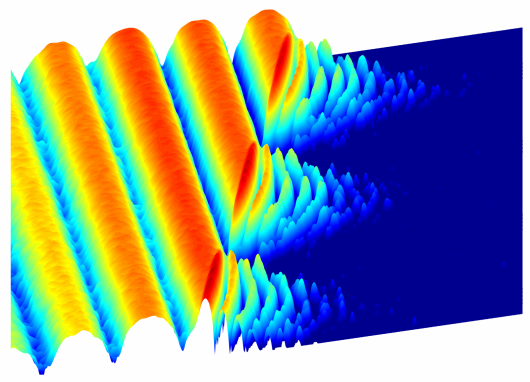"Solid" light reveals new insights about quantum mechanics
By Richard Moss
September 18, 2014

Researchers at Princeton University have devised a method for giving light the properties of liquids and solids, with huge potential ramifications in the study of quantum mechanics and other areas of physics (Image: Shutterstock)
Scientists have been observing the wave-particle duality of light for centuries, but never has light been seen to behave like matter. Until now, that is. Researchers at Princeton University have devised a method for giving light the properties of liquids and solids, with huge potential ramifications in the study of quantum mechanics and other areas of physics.
They are not, we should be clear, actually transforming light into a crystal, or any other form of matter – though turning light into matter and binding its photons together to form simple molecules are both being explored elsewhere. Rather, the research involved locking individual photons together in a lattice – what the researchers describe as "macroscopic quantum self-trapping" – such that they become like a solid or fluid object.
"Here we set up a situation where light effectively behaves like a particle in the sense that two photons can interact very strongly," said researcher Hakan Türeci, an assistant professor of electrical engineering at Princeton. "In one mode of operation, light sloshes back and forth like a liquid; in the other, it freezes."
The researchers constructed a small device made of superconducting materials that contain 100 billion atoms. These atoms were engineered to act together as a single unit, or an artificial atom. The artificial atom was then placed close to a superconducting wire carrying photons, whereupon the photons became entangled (linked or correlated, without necessarily being physically connected) such that they began exhibiting the properties of atoms.

Unlike atoms, photons do not normally interact with each other, but here they oscillated almost uniformly and at a critical point, as some photons leaked out into the surrounding environment, these oscillations began to produce quantum divergent behavior. The photons, in other words, could be in two states at once: a liquid and a solid. (Much like the famous Schrödinger's Cat thought experiment, in which a cat in a box is simultaneously both alive and dead.)
The current device has only two sites where light can be entangled with the artificial atom, but the researchers plan on scaling it up to allow more interactions and thus more complex systems – from a simple molecule to entire materials. They hope to then use this technique of solidifying light to study dissipation and decoherence from quantum systems – to simulate subatomic behavior, essentially, with tools developed for quantum computing.
Large numbers of particles are usually modeled statistically under the assumption that there's no interaction between particles and the system is at equilibrium. But, as the researchers note in their popular summary, "the world around us is rarely in equilibrium." The solidified light, by contrast, provides opportunities to observe such systems just as they diverge from equilibrium.
The researchers also hope to make the frozen light behave like more exotic forms of matter (like superfluids) and to mimic materials that have never been observed in nature (only hypothesized by physicists), perhaps leading to the development of room-temperature superconductors and other world-changing hypothetical materials that could have especially-dramatic consequences in computing, power generation, electronic storage, and many other areas.
"There is a lot of new physics that can be done even with these small systems," said James Raftery, a co-author on the study. "But as we scale up, we will be able to tackle some really interesting questions."
The research is described in a paper published in the journal Physical Review X.
Source: Princeton University
copyright © Gizmag 2003 - 2014